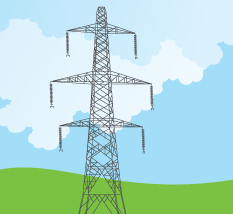How Electricity Gets to You
 Once electricity has been generated, it is transported on extra high voltage power lines suspended on pylons. This enables electricity to be transmitted across long distances – it’s like a motorway network for power!
Once electricity has been generated, it is transported on extra high voltage power lines suspended on pylons. This enables electricity to be transmitted across long distances – it’s like a motorway network for power!
Power lines carried on pylons feed in to large substations. Transformers in substations reduce the strength, or the voltage, of electricity. Power lines or underground cables leaving the substation carry electricity at a lower voltage.
As the journey of electricity continues, the distribution network feeds towns with many smaller, lower voltage power lines carried on wooden poles, underground cables and substations - like the ‘B’ roads of the power network!
Electricity is distributed through a series of substations, each time reducing its voltage until it is suitable for the customer to use. Smaller substations can either be small metal boxes mounted on wooden poles in rural areas or small buildings in most communities.

Substations near our homes and schools generally ensure that the electricity we are supplied in our homes and schools is at 230 volts. These substations can look very different; some are small brick buildings, some are plastic and some just have metal fences around a metal box. They are safe if they are locked and we leave them alone but only authorised personnel from the electricity distribution company can go inside them.
Electricity is supplied to our homes by underground cable or overhead power line at 230 volts. The electricity supply cable enters your home through a meter which records how much electricity you are using and a consumer unit (or fusebox) where your main switch and residual current devices (RCDs) are located.
 Finally, your domestic wiring distributes electricity to lights and sockets throughout your home.
Finally, your domestic wiring distributes electricity to lights and sockets throughout your home.
Many people do not recognise equipment on the electricity network, for example, a common misunderstanding is that cables on wooden poles are telephone wires but often they are electricity power lines.
Always look up and look out for overhead lines and look for the yellow and black ‘Danger of Death’ warning sign that is displayed on equipment on the electricity network to warn people of the danger posed by the apparatus.
Click here to see photographs of equipment on the electricity network

Electricity Suppliers & Distributors - What's the Difference?
Electricity distribution companies are responsible for the network of power lines, underground cables, substations etc., that get electricity to your home or business in the area where you live.
